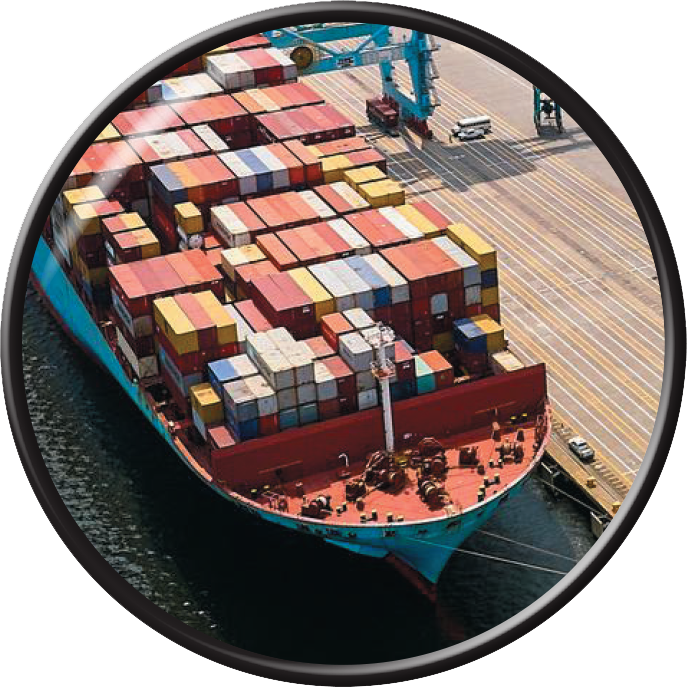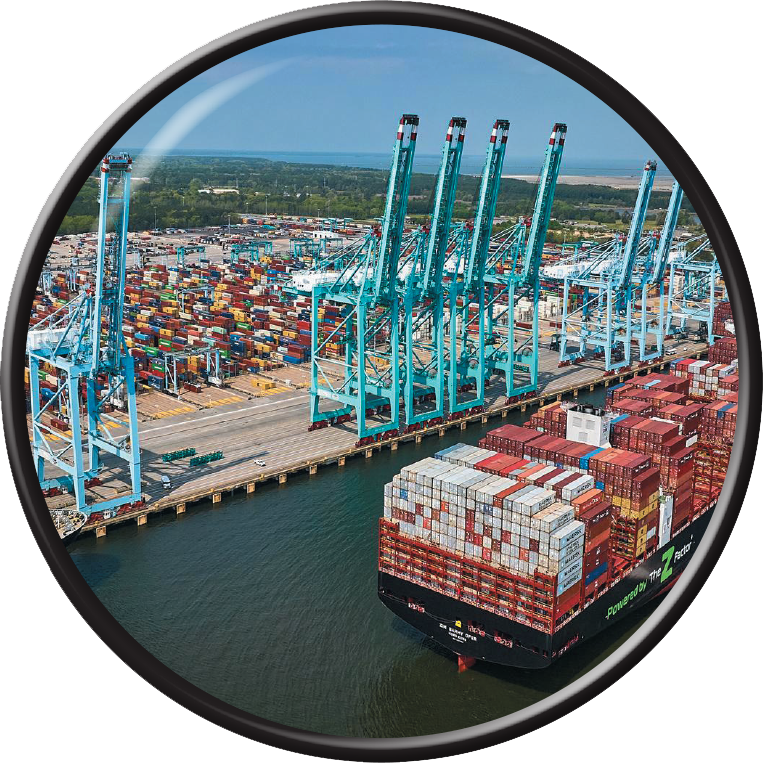
When COVID-19 unmoored the supply chain, it brought an intensified attention to ports across North America. While the spotlight has dimmed some as the pandemic has eased and the supply chain congestion issues have relaxed, many ports continue to see a level of awareness from their communities and regional leaders that remains heightened compared to the prepandemic days.
Attention during the pandemic may have been most acute on those ports that experienced the most severe congestion issues, but Cathie Vick, chief development and public affairs officer for the Virginia Port Authority, said the headlines caused many to look more closely at the ports closer to their homes and to consider how they were faring – and why. For the first time for many, “the connectivity” of the supply chain came into a new focus for those outside the ports industry.
“It’s been a great educational process for everyone on why the supply chain is called a chain,” Vick said. “I think before people didn’t connect the dots as much. They showed up at Target and things were on the shelf and then when they weren’t, people started saying, ‘Well, wait a minute. Why not?’ Or as more people started to point and click and expect things to show up at their home, then they started to think about ‘Well, how does that actually happen? And what do we need in order to be able to keep that going?’ It’s been a big change in perspective.”

Even at an inland port, Ben Hart, executive director of the Utah Inland Port Authority, said the pandemic-related supply chain disruptions and attention “has been a fascinating study in global logistics recalibration.” Central to that has been a more widespread understanding of the flow of cargo and the existence of choke points that can stall the supply chain across the country. In Utah, Hart has seen a chance to emphasize the value of what an inland port can offer.
“It’s drawn a lot of attention to logistics, whether that’s good or bad, but I think it gives us certainly an opportunity to highlight multimodal transportation nearshoring opportunities, recruiting advanced manufacturers back to the United States,” Hart said. “And so I think it definitely has given us more press coverage, but I think it’s also given us an opportunity. Some people would say it’s a threat, but I don’t see it that way – I think it’s an opportunity to really draw attention to the importance of multimodal transportation.”

Partnerships and Leadership
Reece Shaw, ports and maritime project manager, Burns & McDonnell, agreed that the ports’ place in the larger supply chain and the need to connect it all has become better understood. That has brought new opportunities and resources for ports, such as money to make needed capital improvements. For example, he noted that “the amount of grant funding available to ports is pretty impressive, especially considering that other infrastructure in the U.S. – such as bridges and highways – often faces more dire challenges.”
“Generally, the U.S. gateway ports are in pretty good shape, but it’s the connectivity to the rest of the supply chain that sometimes is where the bottlenecks lie,” Shaw said. “So, getting cargo in and out of the terminals is one thing, but efficient integration into the greater supply chain is certainly another greater goal. We must look at the totality of the supply chain to make sense of it all.”
In general, Vick said, ports are finding more partners who are eager to participate and contribute to a stronger supply chain that features the ports.
“They’ve been less of a spectator and more wanting to be a participant – less watching the game and more wanting to be part of the game and asking, ‘how can we help?’” Vick said. “‘How do we help attract these fulfillment centers? How do we support freight planning?’ It’s about bringing these partners in to have a seat at the table rather than just being there for support.”
The Port of Virginia recently held an all-day economic forum at its inland port in the Shenandoah Valley of Virginia that featured a range of participants representing everything from beneficial cargo owners to site selectors and workforce development professionals.
“It was really a good dialogue between industry and government, and we had community leaders from all of those counties participate to do an all-day roundtable on how we work better together to support the overall supply chain and make sure that it’s creating economic opportunity and jobs for the people in those communities,” Vick said.
Stronger engagement that is crystallized through efforts such as the forum helps ports with the “velocity” of development and improvements, Vick said. It also tends to put ports naturally in a position to lead the charge on key issues that connect to the entire supply chain.
“I think it’s extremely important for ports to be leaders because we see all sides of it,” Vick said. “We see it coming from the water, we see it going out by truck, we see it going out by rail. I think there’s a fine line, though – a balance. The port shouldn’t take ownership, but the port should be engaged in informing, sharing data, sharing forecasts of growth, so that the folks who do have ownership of planning for those freight corridors, funding those freight corridors’ rail improvements and road improvements, have everything right here. The collaboration should be there to make sure that they are making decisions based on accurate information.”
For example, Vick said The Port of Virginia helped promote legislation that passed in its state last year requiring local governments to consider freight corridors in their transportation planning.
“It’s about getting everyone from the transportation planning organizations that work with localities on a regional basis to the statewide transportation planning folks to be thinking about not just where is development today, but where’s it going to be in the future and then planning for it, rather than, say, winding up with a bottleneck outside the gate of the port,” Vick said. “We’ve done all this investment, and created efficiency, and we’re super fluid, but if it gets to our gate, and then it can’t move anywhere else that undermines it. That’s one of the things during the pandemic that became clear is that there are different choke points across the supply chain, and we need to be looking at all of them.”

Efficiency, Sustainability and Community Buy-in
Infrastructure expansions often get headlines, but Shaw said many ports have focused on making their existing facilities more efficient after the pandemic – partly due to the attention it brought – often through the adoption of sophisticated technology tools. Sometimes, this efficiency drive is made in lieu of infrastructure expansion and sometimes it comes in alignment with it.
“Ports are making a big push to say, ‘Let’s try to increase existing terminal throughput through workforce up-skilling and/or re-skilling and the incorporation of smart port technological tools in search of efficiency gains,’” Shaw said. “Marine terminal technological-driven efficiency gains – particularly in container terminals – are largely incremental and increasingly involve the use of bi-directional digital twins which are digital representations of port complexes or terminals. The virtual map becomes a 3D interface or organized dataset which can help ports cut emissions, improve safety processes, operational maintenance, predictive analysis, and allow maritime stakeholders to effectively share multiple data sources across a port.
“Through private wireless 5G connectivity, ports will be able to capture massive data from the internet of things sources such as smart sensors, 3D LIDARs, wide dynamic range cameras, automatic identification system information, performance statistics, and maintenance status of cargo handling equipment,” Shaw said. “As this vast amount of data becomes available and manageable, understanding how it can be applied to increasing terminal efficiency is one of the challenges that we’re seeing. It’s about taking all the data that is out there and then utilizing the tools that are becoming available such as AI to try to understand how efficiencies can be gained without building massive infrastructure improvements.”
The increased attention that ports have received makes community buy-in of certain efforts even more important than before. For instance, Hart said the Utah Inland Port Authority faces concerns about environmental impacts of rail development, making engaging on that topic critical.
“We see a really strong connection between trying to help and foster and fix supply chain issues, and ultimately, our purpose and mission as a port,” Hart said. “But I think every port can identify that they have to be able to solve a lot of different issues. I’ve talked with some of my friends at seaports, and they’re trying to solve green energy challenges while also trying to handle logistics. Every port nowadays and every organization across the logistics industry has to wear several hats.”

Shaw said that an emphasis on sustainability – particularly decarbonization – has become widespread after it initially found its footing on the West Coast, bolstered in part by government subsidies. Environmental issues often play an important role in community-port relations and how ports are viewed.
“There’s a real growing awareness of the need to decarbonize the ports and create less impact on the surrounding neighborhoods and the people that utilize the facilities, as well as the global environment – and while still challenging, federal and state grant funding is helping to make it possible,” Shaw said.
The Port of Virginia has a net zero by 2040 program, and Vick said the port has worked with communities on the positive impacts of decarbonization and partnerships that can stem from that effort.
“It’s opened up the conversation for more collaboration with the communities,” Vick said.
In that vein, Hart said one of the key missions for the Utah Inland Port Authority is to partner with other stakeholders in the communities it serves and across the state.
“We have the responsibility and duty to really engage with all of our stakeholders to make sure that we’re growing the economy in the best way possible for our state,” Hart said. “So we have to diversify, especially as we’re kind of a new port system and we’re trying to get things up and running here in the state of Utah. But we have to diversify to make sure that we’re not only meeting logistics goals, but also economic goals for everyone.”
With that mindset, The Port of Virginia embraces an active approach to informing and educating political leaders about the port, its role in the state’s supply chain and its close work with businesses throughout the state, among others. In that way, the port is asking legislators to put it “under the microscope.”
“We try to have them understand the importance of having a port and how it can be an economic engine so that they are working with us from the very beginning,” Hart said. “To be successful, whether that’s in infrastructure, investment, supply chain planning, or freight planning – all of those things – it’s important to open the lines of communication early and make sure we understand what their priorities are and how we can work together. That’s why we’re here.”
 AAPA Seaports
AAPA Seaports


